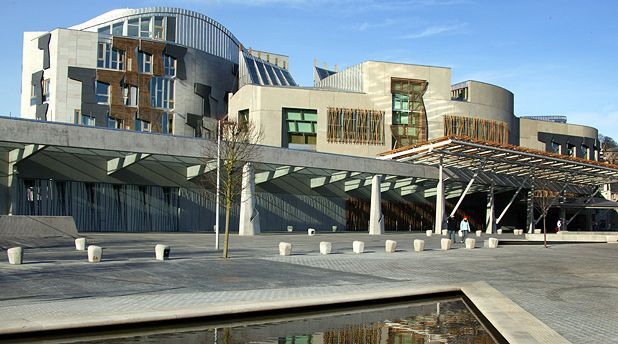From the outset, the building and its construction have been controversial. The choices of location, architect, design, and construction company were all criticised by politicians, the media and the Scottish public. Scheduled to open in 2001, it did so in 2004, more than three years late with an estimated final cost of £414 million, many times higher than initial estimates of between £10m and £40m. A major public inquiry into the handling of the construction, chaired by the former Lord Advocate, Peter Fraser, was established in 2003. The inquiry concluded in September 2004 and criticised the management of the whole project from the realisation of cost increases down to the way in which major design changes were implemented. Despite these criticisms and a mixed public reaction, the building was welcomed by architectural academics and critics. The building aimed to achieve a poetic union between the Scottish landscape, its people, its culture, and the city of Edinburgh. The parliament building won numerous awards including the 2005 Stirling Prize and has been described by landscape architect Charles Jencks as “a tour de force of arts and crafts and quality without parallel in the last 100 years of British architecture“.
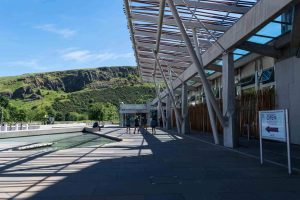 The entranceway is an oddly covered glass roofway leading to an ordinary aluminium revolving door. Stepping beyond the necessary security checks inside I was expecting to be wowed but still nothing, I remained underwhelmed. Walking into the foyer we were efficiently directed to the main chamber public viewing area upstairs where, finally, we did think it looked the part without being much to write home about. So this had cost us £414 million?
The entranceway is an oddly covered glass roofway leading to an ordinary aluminium revolving door. Stepping beyond the necessary security checks inside I was expecting to be wowed but still nothing, I remained underwhelmed. Walking into the foyer we were efficiently directed to the main chamber public viewing area upstairs where, finally, we did think it looked the part without being much to write home about. So this had cost us £414 million? 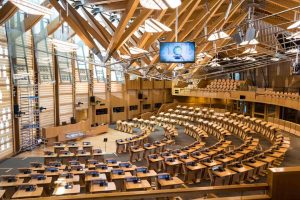 Well, it was quiet in the chamber and pleasant enough so we sat on one of the specially-designed chairs and took it all in. You first notice there’s a lot of glass. We’re in Edinburgh so it’s going to be hot/cold dependant upon the season unless the ventilation and heating systems are very well designed and I wondered whether they are. There’s also a lot of light oak, a very complex roof, lots of specially-designed seats and specially-commissioned light fittings which had special notices explaining their design intentions. In my opinion, if an item needs a notice to explain itself then this says to me that the architect/ designer was probably over-thinking but even after I’d read the explanations and looked back at the seats it made little sense to me. I raised my best Luddite eyebrow.
Well, it was quiet in the chamber and pleasant enough so we sat on one of the specially-designed chairs and took it all in. You first notice there’s a lot of glass. We’re in Edinburgh so it’s going to be hot/cold dependant upon the season unless the ventilation and heating systems are very well designed and I wondered whether they are. There’s also a lot of light oak, a very complex roof, lots of specially-designed seats and specially-commissioned light fittings which had special notices explaining their design intentions. In my opinion, if an item needs a notice to explain itself then this says to me that the architect/ designer was probably over-thinking but even after I’d read the explanations and looked back at the seats it made little sense to me. I raised my best Luddite eyebrow.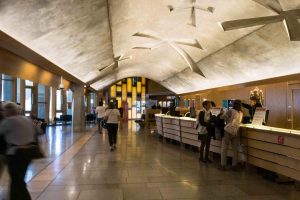 We decided that the ceiling, although carved with artistically-designed saltires and being overly complex again, was too low to give a proper feeling of space let alone grandeur. It looked like a nice hotel lobby and we’ve seen more impressive hotel lobbies. We left and took a stroll around the outside of the building and saw the various carbuncles sticking out of a number of the building walls, the ‘thinking pods’ according to our tour bus guide, who had joked (I think!) that they are largely unused.
We decided that the ceiling, although carved with artistically-designed saltires and being overly complex again, was too low to give a proper feeling of space let alone grandeur. It looked like a nice hotel lobby and we’ve seen more impressive hotel lobbies. We left and took a stroll around the outside of the building and saw the various carbuncles sticking out of a number of the building walls, the ‘thinking pods’ according to our tour bus guide, who had joked (I think!) that they are largely unused. 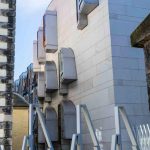 Around each window of the building are what look like large hairdryers but we were explained that they symbolised curtains opening on the workings of the parliament. Of course they are. (sigh!)
Around each window of the building are what look like large hairdryers but we were explained that they symbolised curtains opening on the workings of the parliament. Of course they are. (sigh!)  Embedded into the walls are stones on which is carved various poetry and other Gaelic/Scots prose, just the sort of decoration one might expect on a money-no-object public project. So we got back on our bus still feeling underwhelmed which was a great pity, for me at least, and professionally grumpy that such a huge amount of public money had again been spent on a project that (naturally) went so wrong to achieve something so ….unworthy. Surely we could have done better?
Embedded into the walls are stones on which is carved various poetry and other Gaelic/Scots prose, just the sort of decoration one might expect on a money-no-object public project. So we got back on our bus still feeling underwhelmed which was a great pity, for me at least, and professionally grumpy that such a huge amount of public money had again been spent on a project that (naturally) went so wrong to achieve something so ….unworthy. Surely we could have done better? Why, I specifically wondered, was a Catalan architect commissioned to design and build what should be one of the UK’s premier buildings, particularly when the UK has many world-class and world-leading architects of its own? This isn’t the Sagrada Familia, for goodness sake. We might even be able to finger one or two competent Scottish architects if that was considered important. The problem we, the Great British Public, always have when such public projects are proposed is knowing who the sponsor for such projects actually is so we can simply vote them out when they muck up. In the case of the Scottish Parliament Building it seems to have been one Donald Campbell Dewar, a long-time advocate of Scottish self government if not independence and the inaugural First Minister of Scotland. But Donald died before the building was completed so he was voted out in no uncertain terms as was, incidentally, the Catalan architect, Enric Miralles, so he too never saw his finished project. With sponsor and architect gone presumably thereafter the project was sponsored and directed by people who could spend forwards with impunity and no oversight and blame backwards, a perfect political situation. But who was it who authorised overspending such a vast sum on a public library?
I learned the intended lifespan of the Holyrood building as noted in the building specification is 100 years but a recent news article in the Scotsman reveals that in the 10 years since the building opened in 2004 maintenance costs were a cool £11 million and these costs are expected to rise as the building gets older. Architectural writer David Black, who penned a 2003 book about the troubled Holyrood project, said: “It undoubtedly has a host of problems which aren’t going away. Maintenance costs will inevitably increase, to a point where it would make much more economic sense to tear it down and redevelop the site, possibly around 2020” ….which I think is lovely. There is no chance a tear-down will happen, of course, because it would be politically untenable but I do think this is another example where the public is taken by the hand and walked to the cash withdrawals counter, no-one dreaming of taking any responsibility when things go wrong but ever demanding when things are not exactly what they had in mind. I actually think Tony Blair, PM at the time, was probably unwilling to call out the poor project management as it would reflect badly on the new Parliament. Nevertheless I wish he had done so and not left it to the auditor general. We are all victims of poor public project management, again.

